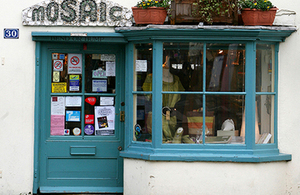Government paves the way for reform of business rates
The review will examine the structure of the current system which is paid annually on 1.8 million properties in England.

The Chief Secretary to the Treasury, Danny Alexander, today (Monday 16 March) launched the most wide-ranging review of national business rates in a generation – paving the way for changes to how businesses across England pay the tax.
The review, set to report back by Budget 2016, will examine the structure of the current system which is paid annually on 1.8 million properties in England. The review will look at how businesses use property, what the UK can learn from other countries about local business taxes, and how we could modernise the system so it better reflects changes in the value of property.
The Chief Secretary launched the review during a speech to local businesses in Cambridge.
Chief Secretary to the Treasury Danny Alexander said:
Our system of business rates was created nearly 30 years ago. Since that time, the worlds of commerce and industry have changed beyond recognition. I’ve been impressed by the representations made by the business community and I know that business rates are a considerable cost.
The government has taken measures to help businesses by capping rates and introducing reliefs for smaller businesses. But now the time has come for a radical review of this important tax. We want to ensure the business rates system is fair, efficient and effective.
Today’s announcement follows the government’s commitment in December 2014 to conduct a review of business rates and implement a £1 billion package to reduce the cost of business rates in 2015-16, with particular support for the smallest businesses and the high street.
From 1 April 2015 the government is:
- increasing help for the high street: increasing the business rates discount for smaller retail premises with a rateable value of £50,000 or below to £1,500 to 31 March 2016, benefiting around 300,000 shops, pubs, cafes and restaurants
- doubling small business rate relief for a further year to 31 March 2016 to provide support for 575,000 of the smallest businesses, and ensuring 385,000 small businesses pay no rates at all
- capping the rise in the business rates multiplier at 2% to benefit all businesses
- extending transitional rate relief to support 16,000 small business facing significant bill increases due to the ending of transitional rate relief
The Treasury has published a discussion paper today (Monday 16 March), outlining the following questions for the review:
- What, in your view, does this evidence suggest about the fairness and sustainability of business rates as a tax based on property values?
- What evidence is there in favour of the government considering a move away from a property based business tax towards alternative tax bases? What are the potential drawbacks of such a move?
- If business rates remain a property tax, how do you suggest business rates could take into account the individual circumstances of businesses such as their size or ability to pay rates?
- What evidence and data can you provide to inform the government’s assessment of the trends in use and occupation of non-domestic property?
- Is there evidence to suggest that changing patterns in property usage are affecting some sectors more than others?
- What examples from other jurisdictions and tax systems should the government consider as part of this review? What do you think are the main lessons for the business rates system in England?
- How can government use business rates to improve the incentive for local authorities to drive local growth?
- What impact will increased local retention of business rate revenue have on business growth? What will the impacts be on local authorities?
- What other local incentives should the government consider to further incentivise business growth?
- Should business rates be reformed to make them more closely reflective of wider economic conditions and if so, how?
- How does the proportion of total operating costs accounted for by business rates vary by the sector and size of a business?
- What is the impact of the business rates system on the competitiveness of UK businesses? Are there any particular impacts on SMEs?
- How could the government better target support for SMEs given that the size of a company may not be reflected in the rateable value of a property it uses?
- Should investment in plant and machinery, energy efficiency improvements or other similar property improvements be treated differently by the business rates system? If so what changes could be made?
- What evidence and analysis should the government take into account when evaluating the impact of and any changes to the range of reliefs and exemptions present in the business rates system?
Key facts about business rates:
- 1990 – national business rates system introduced
- business rates are paid by occupiers of non-domestic properties (e.g. shops, offices, warehouses, factories, guest houses)
- the main aim of business rates is to help raise revenue to pay for local services
- business rates are devolved within the UK
- business rates are paid on 1.8 million non-domestic properties in England each year
- £20.5 billion was brought in from business rates in England in 2013-14
- April 2013 – government introduced the ‘business rates retention scheme’ to allow local government in England to keep 50% of all business rates receipts and therefore 50% of any growth
- some properties are eligible for relief on their business rates (e.g. small business rate relief which has been doubled until March 2016)
- local councils send out business rate bills in February or March each year. The bill is for the following tax year. Some councils offer payment in 12 instalments
Last updated 16 March 2015 + show all updates
-
added link to discussion paper
-
First published.